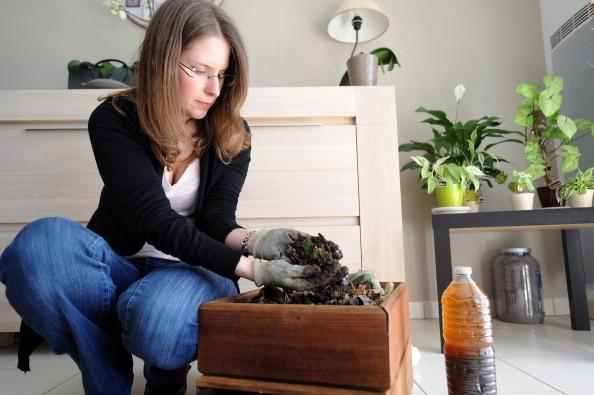Compost tea, compost extract. No matter what term you hang on it, it’s simply compost and water, a perfect lawn and garden feed for those who want a liquid supplement for their plants and soil, those who only make small amounts of compost, or for those who may not have the physical strength to spread compost. But how one best makes compost tea is widely debated.
The big idea behind compost tea is that it makes nutrients quickly available to plants, and the microbe-rich solution suppresses plant disease and helps build healthy soil. Compost and hence compost tea contain a wide range of nutrients and micronutrients like calcium, sulfur, boron, iron and magnesium, which aren’t available in commercial N-P-K fertilizers. But every load of compost has different nutrient ratios, depending on its source material, so it’s impossible to say how much of any one element is in your compost. But healthful bacteria is plentiful in any properly finished compost, and the organic material helps plants use nutrients in the soil quickly and efficiently.
Don’t believe that the stuff that drains out of the bottom of your compost pile is compost tea – it definitely is not. It’s called compost leachate and should never be applied to your garden plants. Compost leachate usually carries very high concentrations of salts and microbes which may be detrimental to your plants and soil.
Aerobic vs Non-Aerobic Compost Tea
There are two methods of making compost tea: non-aerobically or aerobically, and which is the superior tea is widely contested. The difference is one has air forced into it via bubbling (aerobic), and one is simply stirred once a day (non-aerobic).
Many articles describe elaborate contraptions for making aerobic compost tea. But this simply complicates what should be a very simple process (some people want to endlessly tinker with things which don’t need to be fixed). Dozens of research papers have shown that aerobic compost tea (compared to non-aerobic compost tea) provides no significant protection against plant disease. The additional microbes in the aerobic brew, dependent on high concentrations of oxygen, are ultimately deposited into a mostly non-aerobic medium (your soil), and the level of oxygen in soil will not support the aerobic bacteria. The aerobic microbe population crashes almost immediately.
Non-aerobic compost tea, loaded with microbes which flourish in soil, is simple to make, simple to use, and is brilliant at making nutrients available to plants and suppressing disease. How it suppresses disease is still a bit of a mystery, but in A/B garden plot research conducted by the Rodale Institute, the benefits were clear. But compost tea is not a magic bullet for disease suppression or fertilizing. You should also practice crop rotation in your vegetable garden, judicious pruning when necessary, top-dressing with compost, and mulching where needed.
Non-Aerated Compost Tea Recipe
- Fill a 5 gallon bucket 3/4 of the way full. If filling with chlorinated municipal water, let sit overnight so the chlorine evaporates.
- Add 1 quart of finished, properly cured compost to the bucket of water (there’s a huge difference in microbial activity and the types of microbes in finished and unfinished compost). No need to wrap the compost in burlap or cheese cloth, just drop it right into the bucket. One quart in 5 gallons is a 1:20 ratio, which should be observed for any size container.
- Stir well.
- Cover the bucket loosely to reduce evaporation – a piece of plywood is perfect. Do not seal the bucket tight, as the “good” bacteria require air to multiply.
- Store the compost tea bucket in shady place, out of direct sunlight (UV rays and high temperatures kill beneficial bacteria).
- Stir thoroughly once per day.
- After 10 days, compost tea is ready to use (can be used sooner, but microbe count will be lower).
- Compost tea made in this manner can be stored for up to 6 months, and can be used at any stage of your plant’s development – from seed starting through maturity.
- Dilute compost tea at least 1:5 with fresh water before applying to plants, lawn, and soil. Your compost tea may contain inorganic salts like magnesium sulfide, and if not diluted, these elements may damage plants. You can dilute the tea as high as 1:60 and it will still be effective.
- Before using, strain with a cheesecloth or fine screen to remove any material which might clog your watering can or feeder.
- Can be used as a foliar spray or soil drench, 2-4 times during the season.
- Use heavy applications after garden harvest to replenish soil microbes, at a rate of 1 gallon per square foot. This also imparts superior disease suppression.
It’s not necessary and in fact not recommended that you add “starters” like molasses or other sugars to the compost tea. Sugars are the favorite growth medium for E.Coli bacteria, and you can bet that your compost contains at least a small amount of this most common bacteria, especially if you use animal manures in your compost. E.Coli occurs naturally, but is kept under control by beneficial bacteria. If you encourage E.Coli’s growth with sugars, you could be asking for real trouble, like intestinal illness or worse. When you come right down to it, everything your plants need are already contained in the compost, so why waste money adding additional ingredients?
This article was originally written and published by Todd Heft, the head administrator for bigblogofgardening.com. For the original article and more information, please click HERE.




